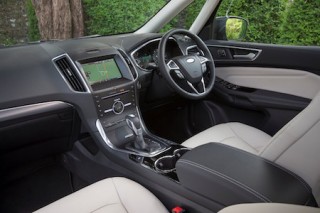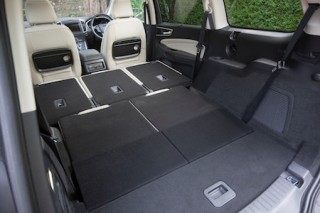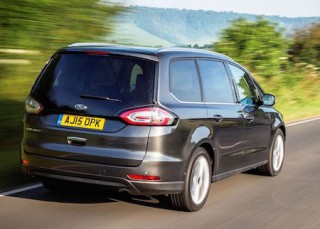 With over 200,000 visitors expected at this year’s Goodwood Festival of Speed and its Moving Motor Show event before it closes tomorrow, Ford is using the prestigious motoring occasion to give the all-new Galaxy seven seater large MPV range its European debut.
With over 200,000 visitors expected at this year’s Goodwood Festival of Speed and its Moving Motor Show event before it closes tomorrow, Ford is using the prestigious motoring occasion to give the all-new Galaxy seven seater large MPV range its European debut.
Right hand drive models will arrive in UK showrooms in August in time for the new registration plate sales month of September.
Paul Baynes, Ford of Britain’s Galaxy Product Manager said at this week’s media launch, “Sales this year will be around 3,000 units increasing to 6,250 next year. This represents a market share of 50.7% of the large MPV segment in the UK, the largest market in Europe for Galaxy sales.”
With the choice of two petrol engines 1.5 and 2.0-litre EcoBoost units and four 2.0-litre TDCi turbodiesel units, prices start from £26,445 and rise to £36,760. There is the choice, depending on the engine chosen, of Zetec, Titanium and Titanium X levels of specification plus a wide range of options and options packs including the newly announced front view 180-degree camera system that sees around corners and costs £400.
Paul Baynes said Zetec specification will take 50% of UK sales with Titanium 35% and Titanium X appealing to 15% of customers. He added that 98% of customers will choose a diesel engine with the 2.0-litre TDCi 150hp turbodiesel unit being the most popular choice with 58% of sales. The expected most popular new Galaxy model will be the 2.0-ltre TDCi 150hp manual with Zetec specification and it costs £28,345.
Baynes added that around 54% of users will choose a manual transmission, 65% of registrations will be accounted for by fleet and business customers, 35% will be retail customers and they would not be doing any daily rental deals to protect residual values. He said already the residual value projection for the most popular model was £1,950 more than the outgoing comparative version and over a two-year period the retained value was 48%.
All wheel drive versions are also included in the new model line-up powered by either a 2.0-litre TDCi 150hp turbodiesel unit with manual transmission and priced at £31,545 or a 2.0-litre TDCi 180hp turbodiesel with a six-speed Powershift automatic gearbox priced at £36,760. Paul Baynes said these AWD versions together are only expected to take between 2 to 3% of UK sales.
 The Ford Galaxy was first introduced to the UK market in 1995 with over 750,000 sold worldwide and the new model is the third generation in the UK, fourth generation globally.
The Ford Galaxy was first introduced to the UK market in 1995 with over 750,000 sold worldwide and the new model is the third generation in the UK, fourth generation globally.
The latest Galaxy shares the same platform as the latest Mondeo, new S-Max sports MPV, also due to go on sale in August, and the Ford Edge large SUV which will also go on sale later this year.
The Galaxy, Mondeo and S-Max are built at Ford’s Valencia facility in Spain. All TDCi diesel engines come from Dagenham UK, the 1.5-litre EcoBoost 160hp petrol engine is built at Bridgend South Wales with the 2.0-litre EcoBoost petrol unit being supplied by the Valencia engine plant.
‘Upgrade to First Class’ is the advertising strapline for the new and more luxurious Ford Galaxy and the newcomer is certainly the sleekest, most stylish, most well equipped, most user-friendly and most fuel and CO2 efficient yet.
At the front is the latest interpretation of the Ford ‘face’, the distinctive trapezoidal grille positioned above a full width lower grille flanked by sleek headlights. At the front the A-pillars either side of a huge windscreen retain their twin spar design so at times front quarter visibility is impaired but B and C slimmer pillars allow for large windows above the raised beltline so offering excellent visibility for passengers. Although its sleek elongated, high roof design makes it look thoroughly modern it is easy to recognise the new model as a Ford Galaxy. It is 4,848mm in length, 1,916mm wide and 1,747mm high so it is big and imposing and it looks every millimetre a thoroughly modern people-carrier or MPV. The doors are wide opening to allow easy access to three rows of seats carrying a total of seven passengers.
At the rear is a tall and wide tailgate allowing easy access to a load space ranging from just 300-litres with all seats in use, 1,301-litres in five seat mode and a huge 2,330-litres with just the two front seats occupied and the five individual rear seats folded down to provide a bumper level flat load floor. Whether it is carrying the family, chauffeuring business passengers, taxi/private hire use or active sporty individuals who want to carry their sports equipment inside a vehicle rather than loaded on the roof or tailgate, the new Galaxy is cavernous.
If all that load space isn’t enough and towing of a boat, caravan or trailer is required the braked towing weights are 1,800kg for the petrol models and 2,000kg for diesel powered models.
 A total redesign of the second and third row of seats provided more variable adjustment with 10mm more headroom and the third row of seats offers more legroom and up to 40mm more headroom. The third row of seats, as an option, can be raised or lowered at the touch of a button. The second row of seats slide and tilt forward in one easy action for access to the third row.
A total redesign of the second and third row of seats provided more variable adjustment with 10mm more headroom and the third row of seats offers more legroom and up to 40mm more headroom. The third row of seats, as an option, can be raised or lowered at the touch of a button. The second row of seats slide and tilt forward in one easy action for access to the third row.
Further improvements to ride quality and passenger comfort includes the use of more sound deadening and insulation material giving the latest Galaxy a ‘premium’ ambience. The most notable improvement is from the rear link suspension which provides a smoother, more compliant and quieter ride. Gone are the van-like driving characteristics and in has come car-like ride comfort with sharper handling.
The higher levels of standard specification and the use of driving aid technologies are also impressive and again a carry-over from what Ford are supplying with their passenger cars. The vehicles have Ford’s latest SYNC 2 infotainment system which includes emergency assistance. The most popular Zetec specification includes such items as SYNC 2 with voice control, Bluetooth, 8-inch touchscreen and DAB radio,17-inch alloy wheels, front and rear parking sensors, electric operated folding door mirrors, dual zone air conditioning, starter button, mini spare wheel, electric handbrake and roof rails. Titanium specification additions include navigation system with European mapping, privacy glass, automatic headlights and wipers, keyless entry, lane keeping aid, traffic sign recognition and cruise control with speed limiter. The top-spec Titanium X has a panoramic opening sunroof with sunblind, leather upholstery with electrically operated 10-way driver’s seat, 8-way power operated passenger front seat, power operated tailgate, active park assist with parallel and perpendicular parking options and a rear view camera.
For the first media test driving programme at Goodwood only the 2.0-litre, 180hp TDCi turbodiesel engine option was available. This will be the second most popular choice by customers with 20% of UK buyers expected to choose this unit against the 58% who will choose the cheaper 2.0-litre TDCi 150hp engine. All engines, petrol and diesel, have Auto-Stop-Start fitted as standard. The most popular 150hp unit with a six-speed manual gearbox has a top speed of 121mph, zero to 62mph takes 10.9-seconds, the Combined Cycle fuel economy is 56.5mpg with CO2 emissions of 129g/km.
By comparison the 2.0-litre 180hp TDCi unit I drove, again with a six-speed manual gearbox, has a top speed of 129mph, zero to 62mph takes 9.8-seconds, Combined Cycle fuel economy is again 56.5mpg with CO2 emissions also of 129g/km. This means VED road tax will cost £0 for the First Year rate and then £110 for Year Two onwards. Price-wise the 150PS unit costs £800 less to buy than the 180hp unit. However whilst the 150hp unit is available with all three levels of specification, the 180hp engine is not available for the most popular and cheaper Zetec level.
 Another important comparison is the torque output for driving response. The 150hp unit produces 350Nm from 2,000rpm, the 180hp unit I tried develops 400Nm also from 2,000rpm. Just that extra ‘grunt’ will make a difference to the flexibility and response particularly if the vehicle is loaded. To maximise fuel economy and lower emissions fifth and sixth gear ratios lean towards being ‘long-legged’ and I found driving busy rural and winding country roads around the Goodwood area needed a significant amount of changing down from sixth to fifth or even fourth to keep the vehicle moving along in an effortless manner. It is also a little quicker for acceleration. For the sake of the extra money I’d opt for the 180hp TDCi unit over the 150hp but as I have said a customer will need to move up from the most popular Zetec spec to Titanium to do that. For the record my 60-miles of test driving using mainly country roads returned a real-life 42.9mpg, significantly less than the official 56.5mpg.
Another important comparison is the torque output for driving response. The 150hp unit produces 350Nm from 2,000rpm, the 180hp unit I tried develops 400Nm also from 2,000rpm. Just that extra ‘grunt’ will make a difference to the flexibility and response particularly if the vehicle is loaded. To maximise fuel economy and lower emissions fifth and sixth gear ratios lean towards being ‘long-legged’ and I found driving busy rural and winding country roads around the Goodwood area needed a significant amount of changing down from sixth to fifth or even fourth to keep the vehicle moving along in an effortless manner. It is also a little quicker for acceleration. For the sake of the extra money I’d opt for the 180hp TDCi unit over the 150hp but as I have said a customer will need to move up from the most popular Zetec spec to Titanium to do that. For the record my 60-miles of test driving using mainly country roads returned a real-life 42.9mpg, significantly less than the official 56.5mpg.
The new Ford Galaxy is a huge improvement in every way over the last generation. Because of new engine technology, added specification and a significantly improved stylish body, prices have increased.
Around £700 is the increase for the least expensive version to around £1,700 for the best selling version, so you do get ‘more bangs for your buck’.
MILESTONES:
Ford Galaxy 2.0-litre, TDCi 180hp manual, Titanium, 5-door/7-seater MPV. Engine/transmission: 2.0-litre, 4-cylinder, common-rail direct injection turbodiesel 180hp, 400Nm of torque from 2,000rpm, 6-speed manual.
Performance: 129mph, 0-62mph 9.8-seconds, 56.5mpg Combined Cycle (42.9mpg o test), CO2 129g/km, VED road tax £0 First Year/£110 Year Two onwards, BIK company car tax 23%. Insurance group: tbc. Warranty: 3-years/60,000-miles. Dimensions/capacities: L 4,848mm, W 1,916mm, H 1,747mm, 7-seats, boot/load space 300 to 2,339-litres, braked towing weight 2,000kg.
For: Improved in most every way from previous versions, comfortable, roomy, clever seating, sleeker premium brand styling, new generation driving aids.
Against: Some cheaper looking plastic finish on the deep fascia panel, wind noise, high 5 and 6 gear ratios dull engine flexibility and mid-range response, faces strong sales competition from the new Ford S-Max in a market sector that is declining in overall sales in favour of large SUVs.
© David Miles

